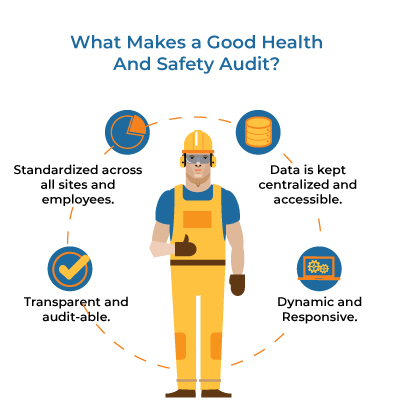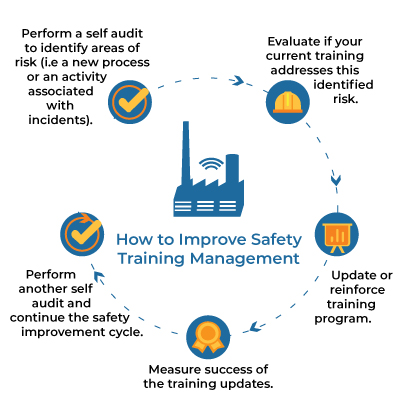 Safety audits, both internal and external are a vital part of maintaining your safety culture and feeding your virtuous cycle of continuous improvement. For most Health and Safety professionals that shouldn't be a revelation. However, we're going to deep dive into a specific element of safety culture that often gets forgotten: how safety auditing should be used to improve your Health and Safety training management specifically. The goal of this article is to show you how to implement a safety auditing system that gives you the data and documentation needed to continuously improve your safety training program.
Safety audits, both internal and external are a vital part of maintaining your safety culture and feeding your virtuous cycle of continuous improvement. For most Health and Safety professionals that shouldn't be a revelation. However, we're going to deep dive into a specific element of safety culture that often gets forgotten: how safety auditing should be used to improve your Health and Safety training management specifically. The goal of this article is to show you how to implement a safety auditing system that gives you the data and documentation needed to continuously improve your safety training program.
Let's start by clarifying what we mean by a health & safety audit - there's a few different interpretations of an "audit" based on your role and perspective. Many people only think of audits as having a regulator send an OSHA investigator to drop by your site, walk around with a checklist, and try to find ways to fine your organization. The findings and recommendations from these types of audits should definitely be implemented into your process safety management, but it's important to note that this is a very reactive type of safety management. What's more powerful is a safety culture that encourages proactive cycles of continuous improvement, and for that you need internal self safety audits.
Why To Do Internal Safety Audits
An internal, or self safety audit is all about inspecting your processes, workers, safety training, and other safety culture elements in order to generate a comprehensive list of the leading indicators for incidents and injuries, and address them head on before they manifest as a real-world event. A safety self audit should help you connect the dots between routine processes and safety training to identify where there are gaps in employee knowledge or where there are unforeseen risks which require you to modify your existing safety training to give your workers the information they need to function safely. A self-audit is focused on prevention and risk mitigation rather than responding to an incident after the fact - which ultimately saves you time and keeps your safety compliance record clean.
Another valuable reason to perform internal health and safety audits is that they can make your regulator audits, like an inspection by OSHA, less painful and costly. On top of the primary benefit of helping prevent OSHA violations, self safety audits also demonstrate in a documented manner that your business take safety seriously and having internal audit records can go a long way in setting a positive tone for your OSHA auditor's mindset. The organizations with the cleanest OSHA reputations are those that not only pass inspections but demonstrate an ongoing, internal safety culture that is maintained independent of OSHA enforcing action from the outside.
Safety Self Audits also create legal defenses—demonstrating to regulators that you are willing to self-discover and disclose those findings with a safety plan for compliance. Conducting audits creates an affirmative defense of “unpreventable employee misconduct.” According to OSHA’s Field Operations Manual (pg. 5-5, 5-6), no citation may be issued if there is unpreventable employee misconduct that led to the violation, but the employer must have documented proof of:
- A safety program including work rules, training, and equipment designed to prevent the violation.
- Adequate communication of these rules to employees.
- Steps to discover and rectify violations of its safety rules.
- Enforcement in official safety procedure for safety programs.
This defense covers facilities that have sound safety auditing and training practices with added protection.
How To Do a Successful Internal Safety Audit
It doesn't take much convincing for most EHS professionals to understand the theory of why a safety audit is important, but the how is often another question entirely. Safety audits can often take a lot of time and resources to do properly, and if they aren't done in a standardized manner on a regular basis then you're chasing after a moving target. It can take a lot of effort to convince executives that regular self Health & safety audits are needed, partially because H&S managers aren't always crystal clear in what should be done.
There's no magic bullet solution to what your internal safety audit should look like since it fundamentally will be tailored to your specific processes, material inventory, and other operations. There are, however, a few key elements of any internal health & safety inspection that should be represented in your auditing plan.

What Makes a Good Audit?
- Standardized across all sites and employees. An audit should be performed the same way and use the same questions no matter where it is taking place and who is performing the audit. Of course, questions that don't apply to a particular site can be excluded, but H&S managers should be trained to understand the audit questionnaire in its entirety.
- Data is kept centralized and accessible. Whenever an audit is done, massive amounts of important safety data is generated. However, that data needs to be managed correctly before it can even be put to use - and that means keeping it centralized in one database rather than siloed in separate spreadsheets or saved locally at each audited site. By keeping things centralized, you'll be able to compare data more easily and identify trends.
- Transparent and audit-able. Your organization needs to know exactly when, where, and by whom an audit was performed, not only for your own compliance records but to help ensure accountability and accuracy.
- Dynamic and Responsive. Audits should be reliable and standardized, but not set in stone. When processes change or new materials/chemicals are introduced, audit questionnaires should be updated to reflect these new risks. It's also important that your audits provide some sort of dynamic communication process that updates key stakeholders of any findings or action items.
How Does Safety Auditing Software Work?
How to Automate Health & Safety Audits
There will always be a skilled worker at the core of any safety audit, but that doesn't mean there isn't a wide range of ways that you can implement automation tools into your audit management. After all, automation is now widely accepted as the next step in industrial evolution.
Here are some of the ways you can automate auditing to help streamline the entire process:
- Automate reminders and task assignment for safety auditing to ensure self audits occurs on a regular schedule.
- Enforce record keeping and data quality with data QAQC automation. An electronic audit questionnaire should include a way to cross reference other employee records in your system - for example, employee IDs associated with one site shouldn't be an option in drop-down menus for a different site.
- Automatic creation of audit reports based on entered responses. Once your team completes an audit, automation can instantly roll that data up into a formatted report. This small step can help save time between completing a questionnaire and the data becoming actionable in the hand of a safety manager or executive.
- Automate triggers for corrective actions based on questionnaire responses. If you are using a software platform for your safety audit checklists, you can have certain responses automatically trigger CAPA task delegation to your team. For example, if an employee is involved in an incident, you can have a task assigned to them to retake the appropriate safety training course.
- Internal benchmarking and KPIs are possible when your audit data is saved in one central database where a reporting software can easily compare and correlate audit findings.
What is Health & Safety Training Management
H&S Training itself covers a lot of different topics, and just like audits they depend on what your processes are and which chemicals are in your inventory. But safety training management is a slightly different story.
Health and Safety training management is all about keeping your training procedures at their best to ensure that staff are properly educated about safety risks and how to prevent incidents or injuries. Managing a training program for your facility requires:
- Measuring performance of both employees and training courses for efficacy. Using leading and lagging safety indicators you should be able to tell if your training is having an impact or not.
- Scheduling and tracking training and refresher courses so that staff have the most recent information available.
- Updating systems and tools to keep up with the latest technology in training best practices (for example, replacing slideshows with video, adding scored quizzes, etc.)
- Changing training courses to reflect changes in processes.
- Capturing and communicating training KPIs and relevant safety KPIs to stakeholders.
How to Improve Safety Training Management
This is where everything ties together: the goal of internal safety audits is to generate KPIs and data that is used to feed your continuous improvement cycle.

2. Evaluate if your current training addresses this identified risk.
3. Update or reinforce training program.
4. Measure success of the training updates.
5. Perform another self audit and continue the safety improvement cycle.
Continuous improvement to established practices, like training your staff based on your findings, not only proves your dedication to improvement but also demonstrates your efforts to make changes toward a safer environment. When you decide to perform a self-audit, you must also prepare to implement any required changes to eliminate and/or mitigate any discovered hazards. For example, if your safety auditing team notices that there are a high number of incidents involving a specific machine, it is the responsibility of managers to re-train workers handling that machine to prevent future injury and incidents.
We encourage companies to self correct and connect compliance shortfalls discovered with training, because training increases efficiency and enables employees to be able to perform their jobs properly and more safely. Detailed tracking and record keeping of training is important for providing evidence of the employer’s compliance with internal and external laws and regulations — showing who was trained, what they were trained on, and what future training might be needed.
OSHA must see the training documents and certifications of your workers as proof of your audit. Therefore, we suggest you also use training tracking tools consolidated in a single database for better organization. Due to compliance requirements your facility should also have detailed reports to display data about internal training and attendance, training score, and missed training. Adding additional training information like employee certificates, photos, and images for OSHA compliance officers protects responsible facilities that properly train their employees. OSHA encourages facilities to voluntary discover, disclose, and correct any violations with quality training. Facilities that provide quality training to workers have lower incidents and uphold the mission of OSHA assuring the safe and healthful working conditions for workers.
How Does Training Management Help With OSHA Audits?
With clear, organized records of safety audits and trainings your facility can confidently prove to OSHA your facility’s compliance with CFR Title 29 safety regulations. By voluntary discovering, disclosing, correcting, and preventing the recurrence of violations you demonstrate an act of good faith to regulators.
In order to reap these benefits however, you will need to have strong documentation about your internal auditing and safety training management efforts. OSHA inspectors will determine if you are documenting your safety and health program activities properly and verify if your those programs and procedures are working. Almost all OSHA inspections begin with a review of your written documents, ranging from your injury and illness records, safety manuals, OSHA-required programs, and safety training procedures and training records.
If you have a safety training management program in place, especially one that follows the continuous improvement cycle detailed above with audits as the backbone, you should be automatically generating all of this important documentation simply through your cycle's steps. By ensuring audits are centralized and accessible, you'll also be making it easier for OSHA auditors to review and greenlight your safety records.
Key Elements of a Training System
Modern manufacturing businesses have generally determined that training programs require some sort of training software, also known as a Learning Management System (LMS), replacing pen and paper training with online/digital training courses.
As part of your continuous improvement cycle for safety training management, you should consider shifting the platform you use to one that includes these capabilities and supports learning best practices:
- SCORM compliant. This means that your LMS platform is able to integrate and deliver SCORM training packages to your team, letting you implement new training courses or updated training courses without starting from scratch each time or having to reconfigure the rest of your LMS. For example, if you add a new process to your workflow, you can simply upload a standalone SCORM course about that process and slot it into your existing training without disrupting what's working. SCORMs can also be purchased from safety consultants or training organizations, saving you from having to create your courses in house.
- Ability to create custom courses if you want to. Although SCORMs can make your training management easier, there may be instances when you want to create a custom training course for your employees. A good LMS will make it simple for you to create a custom course if needed.
- Create quizzes and exams and track employee scores. Employee scores aren't just important for ensuring they were paying attention and absorbing information, scores are also a vital KPI for measuring the success of your training course. If employees are consistently scoring low in a particular exam, it is probably evidence of a course not being very illuminating.
- Add videos, photos, and other multi-media elements. The age of simply clicking through a PowerPoint slideshow are gone. Experts have found that employees learn better when they can see real world photos of what they'll see on site, or even better, watch a video of the process.
How to Implement a Training Management Software
Having a training software is a vital step in a continuously improving training management system - moving away from disparate systems into one central system is fundamental in eliminating data silos from your organization, and for achieving the agility needed to respond quickly to changes in processes.
Because there's even more to say on this topic, ERA's Health & Safety team has developed a short PDF guide that will cover this topic in more detail. It's a free download, simply click the button below.
This Blog Was Co-Authored By:


Tags:
EHS Training
July 8, 2020

Comments